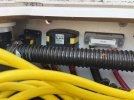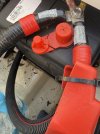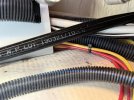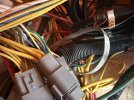fallard
Member
- Joined
- May 29, 2025
- Messages
- 9
- Fluid Motion Model
- R-27 (Outboard)
- Hull Identification Number
- FMLT2741K819
- Vessel Name
- Encore
Looking for verification of ACR wiring in my recently-acquired 2019 R-27. The 2 ACRs in the port cockpit locker have a common wire that is routed to a negative terminal of the ganged house batteries, but it is not connected. The Blue Sea site indicated that this wire might be the connection to the "negative bus bar", to which the battery negatives would be connected, according to the R-19 Owners Manual. It looks like I should just connect it to the battery negative. (The previous owner apparently replaced the batteries within the past year, so it may be an oversight).
Last edited:





